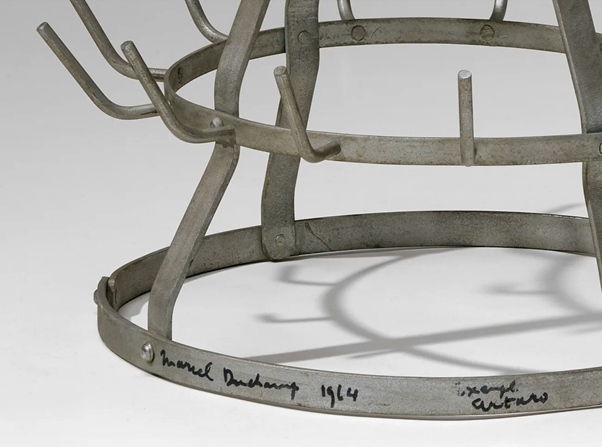Cabanne: How did you come to choose a mass-produced object, a “readymade,” to make a work of art?
Duchamp: Please note that I did not want to make a work of art out of it. The word “readymade” did not appear until 1915, when I went to the United States. It was an interesting word, but when I put a bicycle wheel on a stool, the fork down, there was no idea of a “readymade,” or anything else. It was just a distraction. I didn’t have any special reason to do it, or any intention of showing it, or describing anything. … The word “readymade” thrust itself on me then. It seemed perfect for these things that weren’t works of art, that weren’t sketches, and to which no art terms applied. That’s why I was tempted to make them.
Cabanne: What determined your choice of readymades?
Duchamp: That depended on the object. In general I had to be aware of its “look.” It’s very difficult to choose an object, because at the end of fifteen days, you begin to like it or hate it. You have to approach something with an indifference, as if you had no aesthetic emotion. The choice of readymades is always based on visual indifference and, at the same time, on the total absence of good and bad taste.
Linda Dalrymple Henderson, Duchamp in Context: Science and Technology in the Large Glass and Related Works (Princeton: Princeton University Press, 1998), 64.
The solution to the problem, how to make an artwork that is not art, and thus how art relates to non-art was given by Marcel Duchamp as the “readymade”, a term he coined in 1915 after leaving Paris for New York. The readymade describes a process - a chance encounter - where an already existing object, a commodity, is named, and in this act of naming, it is instituted as art. This act of naming moves the object from its normative function, and puts it in relation to the domain of “art”. Through these acts of negation, the readymade had the effect of transforming art itself, of reducing the artwork to non-art. “Its nomination is a decision, it is a decision that is essentially (not accidentally) indecisive. It is a decision to make art by not making art.” (Kukuljevic, p. 9)
Artistic Practice I will use the “readymade” and its history as an object lesson to understand art’s broad trajectory today. After placing the readymade in its long history, we will explore questions it raises concerning labour, production, skill and deskilling, questions of authorship and nomination. We will look to Duchamp’s Bottle Rack (1914) and in the process of analysing this object through its
- Art-historical and contextual aspects
- Ideological and political frameworks
- Material/Economic aspects (object material investigation and analysis of production)
- Methodologies
we will see how it creates a new constructed image, an image that is not “given”.
This process will help us to see how the readymade itself gave way to a new image. These four registers intertwine and merge into what Wilfrid Sellars described as a “scientific image”. Sellars interpreted the problem of representation, which is based on introducing the difference and relation between the “manifest” and the “scientific image” (of the world). This critiques the view that knowledge can be independent of the conceptual processes which result in perception.) The end product is important, but what seems more important here is the way the ‘readymade’ object enables us to see a shift in the understanding of art itself.
Artistic Practice I will be structured around lectures and praxes; after each lecture students will work in groups of 6, to develop works that respond to the lecture. Please form your groups in the first meeting. Students need to attend each lecture. During the meetings when there is no lecture, the groups will sign up to discuss their works with course tutors.
